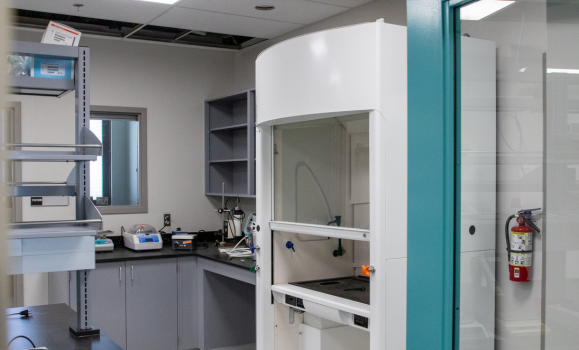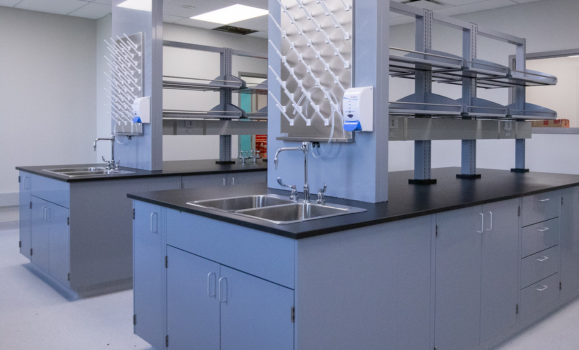Early on a Sunday morning in February 2023, Dr. Christopher Sinal‚Äôs phone buzzed with an unexpected call.Ã˝
As head of the Department of Pharmacology at “π…´ ”∆µ's Faculty of Medicine, he had fielded his share of urgent messages, but nothing could have prepared him for what came next.Ã˝
He was suddenly inundated with shocking photos and videos that would leave him stunned.
Sometime in the early morning of February 5, 2023, with bitter temperatures, three pipes froze and burst in the Sir Charles Tupper Medical Building — one on the twelfth floor, one on the ninth, and one on the sixth floor.
For Dr. Sinal, whose own lab is located on the fifth and sixth floors in the building, along with four others in his department as well as the main administrative offices, the news was devastating.
“I started receiving FaceTime calls and photos showing the extent of the damage — water pouring onto and out of equipment,” he recalls. “It was shocking and when I saw it in person the following day, it was clear this wasn’t going to be resolved quickly. The scope of the damage meant we’d be dealing with this for at least a year, if not longer.”
It was shocking and when I saw it in person the following day, it was clear this wasn’t going to be resolved quickly.
Dr. Sinal‚Äôs lab, along with the others in his department, was completely destroyed, as were their administrative offices. They had to vacate entirely while everything was stripped down to bare concrete and rebuilt from scratch ‚Äî a major disruption for research programs, trainees, and administrative staff.Ã˝
“Some equipment was a clear write-off, like a biosafety cabinet that had a literal waterfall running through it,” says Dr. Sinal. “The bigger challenge has been with equipment that might be damaged but hasn’t been thoroughly tested yet.”
And while equipment can be repaired or replaced, many samples, critical to research success, cannot. As part of the restoration efforts, power was shut off in the Tupper, and countless irreplaceable samples, stored in fridges and freezers throughout the building, were lost, and with them, years of work.Ã˝
Widespread damage
In all departments and on other floors the story remains the same: devastating damage.Ã˝
The flood impacted floors three to 12, which includes all seven basic science departments, administrative offices, and two to three research groups per floor, each with a team of students, postdoctoral trainees, and technicians.Ã˝
Associate Dean of Research Dr. Eileen Denovan-Wright, like Dr. Sinal, recalls receiving the devastating news.
“When we saw images of water pouring in, our hearts sank—it was immediately clear that this was a disaster, with some equipment likely ruined, but initially we thought it might be a manageable inconvenience. As we uncovered more damage, the reality became more severe, and we knew it would be a long recovery process.”
When we saw images of water pouring in, our hearts sank—it was immediately clear that this was a disaster.
“π…´ ”∆µ‚Äôs Facilities Management Operations team immediately mobilized to mitigate the damage and stabilize the building. Environmental Health and Safety was also onsite to address biological, radioactive, or chemical hazards, and the researchers themselves did their best to cover equipment and move items to safe areas. With the enormity of the damage, a restoration partner was brought in to take over clean up from internal staff.Ã˝
When the situation was stabilized, the dean’s office and building administration began the enormous task of relocating the Tupper’s impacted occupants. Within weeks, with some generous accommodation, everyone had found a new, temporary home.
Researchers pivoted remarkably, adjusting their focus, modifying student projects, altering timelines, and forming new collaborations and partnerships. These adaptations, however, often came at the expense of time for new grant applications.Ã˝
‚ÄúIt‚Äôs difficult to gauge the full impact of the flood yet, as it may be many years before the extent of the setbacks is revealed,‚Äù says Dr. Denovan-Wright. ‚ÄúSome grant agencies have provided extensions, but the unequal impact within departments has added complexity. It‚Äôs an ongoing adjustment process.‚ÄùÃ˝
Steps to recovery
It‚Äôs been more than two years since Dr. Sinal received that first phone call, and while he and his team received access to their renovated spaces in late 2024, it was several months before things wereÃ˝ functional to a level comparable to before the flood. For the researchers, staff, and students who were displaced, it has been a very challenging time.Ã˝
‚ÄúUncertainty has been a major challenge, along with the disparity in impact‚Äîsome departments were devastated while others carried on with minimal disruption,‚Äù says Dr. Denovan-Wright. ‚ÄúSupply chain issues, workforce morale, and disruptions to research all added to the strain. The process has been slow, with cumulative delays, which has been disheartening for many.‚ÄùÃ˝Ã˝
A team under the direction of Facilities Management Project Manager Justin Hawkins, along with “π…´ ”∆µ Risk and Insurance Manager Karen Foster, has been working tirelessly since that dreaded day in February 2023. For Justin, trying to minimize disruptions from restoration efforts for the rest of the building has been an enormous task.

The 57-year-old Sir Charles Tupper Medical Building has visibly shown its age throughout the flood and restoration process. Expected issues, such as leaky windows, highlighted the wear and tear typical of a building from 1967, while more surprising structural concerns underscored the challenges of maintaining older infrastructure. Facilities Management, along with design partners DRKR, EastPoint, Strum, and BIRD Construction, and in particular BIRD superintendent Mike Donovan, have worked diligently to address these issues, balancing safety and modern design updates with the building's historical constraints. Efforts have been made to communicate openly and involve stakeholders and positive changes, such as new insulation, updated wiring, and fire doors, have improved the building‚Äôs accessibility and adaptability for the future.Ã˝
‚ÄúDepartment heads and individual researchers have been involved in redesign efforts, reviewing lab layouts, and advising on specific needs,‚Äù says Justin. ‚ÄúNot every accommodation could be made due to budget, schedule, and updated code requirements, but we‚Äôve tried to make the spaces more functional than they were originally.‚ÄùÃ˝Ã˝
After 27 months, the work is nearly complete, and those who were displaced have been returning to affected areas in phases. The remaining occupants will regain access to their spaces in early July. Once they return, activities such as moving contents, unpacking boxes, recalibrating, and servicing dormant equipment can begin.Ã˝
Building resilienceÃ˝
The Tupper flood has heightened awareness of prevention, prompting Facilities Management to prioritize building resilience with action plans for extreme weather events. In flood-affected areas, in addition to the improved exterior insulation, wiring and fire doors, upgrades include floor drains in emergency showers, and enhanced material choices for lab benches and flooring, allowing for easier salvage and reuse if exposed to water. Windows have been sealed, and old concrete penetrations from previously installed sinks have been filled. These improvements are designed to prevent water from spreading between floors, ensuring that any future issues are contained within individual labs.
Beyond these localized upgrades, efforts have been made to harden the entire building, including infrastructure projects and new communication protocols to help building administration and researchers prepare in advance for known storms.

Disasters, while challenging and often overwhelming, have a remarkable way of bringing out the best in people and teams. They inspire resilience, compassion, and a sense of unity as individuals come together to support one another in the face of adversity.Ã˝The Tupper flood is no exception, with Dr. Denovan-Wright, Justin and Karen and the Facilities Management team, Building Services, the Dean‚Äôs Office, and the research community all stepping up to support restoration efforts.Ã˝
“Support and collaboration are key,” says Dr. Denovan-Wright. “Even in a disaster, there’s value in rallying those not directly affected to help. There were great and generous things by many, many people. All I want to do is thank them for everything that they did to make it easier for others.”
Even in a disaster, there’s value in rallying those not directly affected to help.
And while she recognizes the enormous team effort this project has been, Dr. Denovan-Wright, along with Justin and Karen, were instrumental in ensuring things progressed smoothly and received high praise from the impacted researchers and their teams. According to Dr. Sinal, Dr. Denovan-Wright, in particular, was proactive in planning and updating department heads on progress and challenges, and he notes she coordinated with project leads and even helped directly clean up spaces for critical needs.Ã˝
“Dr. Denovan-Wright's contributions deserve recognition — she didn’t sign up for this, but she stepped up with grace and humanity. Managing a situation of this scale while addressing concerns and complaints effectively is no small task. As department heads, we often deal with pieces of everyone’s problems, but Eileen has been handling them on a much larger scale, and she’s done an incredible job.”
The Tupper flood has been an unexpected obstacle for many, and though daunting, it has proved that even in the toughest times, collaboration and determination can lead to incredible outcomes.

